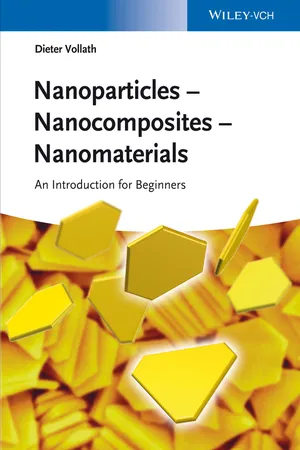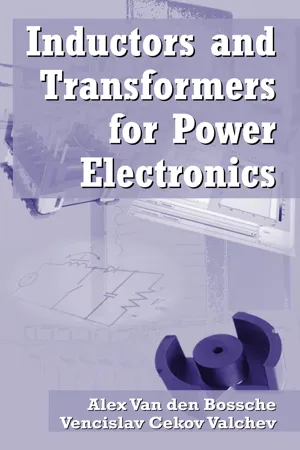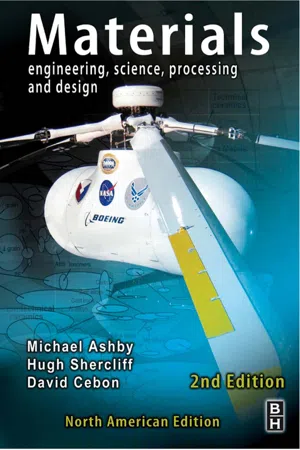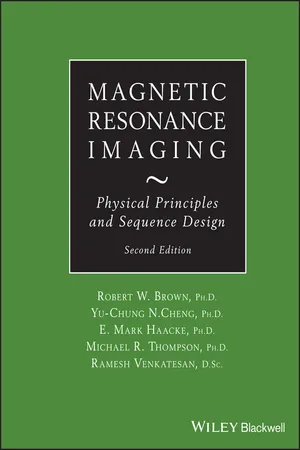Ferrimagnetic Materials
Ferrimagnetic materials are a type of magnetic material characterized by two different sublattices with opposing magnetic moments. These materials exhibit a net magnetization due to the unequal alignment of the magnetic moments within the sublattices. They are commonly used in applications such as magnetic recording media, microwave devices, and magnetic sensors due to their unique magnetic properties.
6 Key excerpts on "Ferrimagnetic Materials"
- eBook - ePub
Nanoparticles for Biomedical Applications
Fundamental Concepts, Biological Interactions and Clinical Applications
- Eun Ji Chung, Lorraine Leon, Carlos Rinaldi(Authors)
- 2019(Publication Date)
- Elsevier(Publisher)
...As shown in Fig. 13.1, they have a positive magnetic susceptibility. Figure 13.1 Illustration of magnetization curves for ferromagnetic, paramagnetic, diamagnetic, and superparamagnetic materials. Here, M S, M R, H C, and χ i are the saturation magnetization, remanent magnetization, coercive field threshold, and the initial susceptibility of the material. Ferromagnets: The magnetic moments in each domain of a ferromagnet are oriented along an easy axis of magnetization, corresponding to a low-energy state. Uncompensated electrons in individual atoms tend to interact, resulting in coupling of spins in a preferred orientation. In ferromagnets, uncompensated spins in individual atoms of a ferromagnetic material may couple either directly (direct exchange) or through an intermediate anion—usually oxygen (super exchange). Unlike paramagnets, when the applied field is removed, they may retain a component of magnetization in the direction of the applied field causing them to be “permanently” magnetized. In fact, the magnetization is kinetically trapped at experimental time scales. As seen in Fig. 13.1, the response is an open curve and these materials exhibit hysteresis. On removal of the field, the extent to which the material remains magnetized is quantified by the remanent magnetization (M R), and the field required to demagnetize the material is the coercive field (H c). Ferromagnetism is mostly seen in metals like iron, nickel, cobalt, and manganese. The field at which the material reaches saturation is a measure of how magnetically “hard” or “soft” it is. In the case of ferromagnets, the coupling of spins need not always be in the same direction, thereby resulting in materials exhibiting special kinds of ferromagnetism. When uncompensated spins are coupled antiparallel to one other, materials are antiferromagnetic. Due to spin canting or lattice defects, they might possess a net magnetization...
- eBook - ePub
Nanoparticles - Nanocomposites – Nanomaterials
An Introduction for Beginners
- Dieter Vollath(Author)
- 2013(Publication Date)
- Wiley-VCH(Publisher)
...This situation is depicted in Figure 8.2 b. Figure 8.2 Antiferromagnetic crystals show antiparallel ordering of the elementary dipoles (a), which are arranged in two different sublattices. As the elementary dipoles compensate each other, such an object has no resulting magnetic moment. This is different for ferrimagnets (b), where the compensation of the spins is not complete; therefore, these materials have a resulting magnetic moment. In view of nanoparticles, antiferromagnetic materials, especially the ferromagnetic variety, are of special importance. In antiferromagnetic compounds like MnO, FeO, α-Fe 2 O 3, etc. an equal number of spins with antiparallel orientation is arranged in two different sublattices (Figure 8.2 a). The magnetic moment of these two sublattices cancels out. This is different in the case of ferrimagnetic compounds, where the magnetic moment of these two sublattices is different. All ferrimagnetic oxides contain iron. They consist either of iron ions with different valency or besides the iron ions a second metal oxide. Typical examples are for an iron compound or MgFe 2 O 4 = MgO⋅Fe 2 O 3 as ternary iron compound. A special case in this context is maghemite, γ-Fe 2 O 3. This compound is ferrimagnetic, because the second sublattice is partly occupied by vacancies. Therefore, the exact formula would be, where stands for vacancies replacing the second type of ions. The temperature range where ferromagnetism and ferrimagnetism exist is limited. The temperature where ferromagnetic or ferromagnetic materials transform into paramagnetic material is called the Curie temperature. In the case of antiferromagnetic materials this temperature is the Néel temperature...
- eBook - ePub
- Vencislav Cekov Valchev, Alex Van den Bossche(Authors)
- 2018(Publication Date)
- CRC Press(Publisher)
...3 Soft Magnetic Materials In this chapter we present different magnetic materials used in power electronics. The manufacturing process, magnetic properties, and specific applications are discussed. The losses in the magnetic materials are considered in detail since they are very important for selection of the right material type and size in the design of high efficiency magnetic components. Iron-based soft magnetic materials, such as laminated cores, powdered iron, and carbonyl iron cores are considered together with amorphous and nanocrystalline materials. Amorphous and nanocrystalline materials combine a high peak induction and low high frequency losses. Ferrites are still a common choice in power electronics, as they have low losses in a wide frequency range (up to 3 MHz for power ferrites) because of their high specific resistivity (usually 1 Ωm and higher). In this chapter the peak values of the induction are used in the discussions. The permeabilities are all relative except for the values of µ and µ 0. 3.1 Magnetic Core Materials The history of magnetism begins centuries before Christ with the discovery of the magnetic properties of a natural mineral called magnetite (Fe 3 O 4). In 1600 William Gilbert published the first scientific study on magnetism: Die Magnete. The new science of electromagnetism was founded by the later contributions by Oersted, Faraday, Maxwell, and Hertz. The development of soft magnetic materials for industrial purposes started with laminated iron and continues with powdered and carbonyl iron, ferrites, amorphous materials, and the newest nanocrystalline materials. The historical development of the soft magnetic materials is shown in Fig. 3.1. In power electronics there are two basic classes of materials used for magnetic cores for transformers and inductors: The first class of materials are alloys of iron and they contain some amounts of other elements, such as silicon (Si), nickel (Ni), chrome (Cr), and cobalt (Co)...
- eBook - ePub
Rad Tech's Guide to MRI
Basic Physics, Instrumentation, and Quality Control
- William H. Faulkner, Euclid Seeram(Authors)
- 2020(Publication Date)
- Wiley-Blackwell(Publisher)
...In this event, since the paramagnetic effects are stronger, the substance exhibits paramagnetic characteristics. Ferromagnetic substances are similar to paramagnetic substances in that they become magnetized when placed in an externally applied magnetic field. Ferromagnetic substances, however, will remain magnetized when the externally applied field is removed. Iron is an example of a ferromagnetic substance. A dipole is a magnet with two poles: north and south. By convention, the magnetic field of a dipole runs from the north pole around to the south pole. When two identical poles are brought together, the resultant fields oppose each other and thus they repel. When two opposite poles are brought together, the resultant fields combine and the two magnets are pulled toward each other. The strength of a magnetic field is expressed in terms of Gauss or Tesla. Gauss is the CGS (Centimeter‐Gram‐Second) unit of magnetic flux density. Tesla is the International Standard (SI) unit of magnetic flux density. The earth's magnetic field strength is approximately 0.5 G. One Tesla equals 10 000 G. Nuclear Magnetism In the early days of MRI, the term nuclear magnetic resonance (NMR) was used. The word nuclear, however, elicited visions of radioactivity, thus the name was changed to MRI. In reality, the term nuclear as it is used in NMR refers to the nucleus of atoms. Atoms which have an odd number of protons in their nucleus are “magnetically active.” This means that certain nuclei have properties that cause them to display magnetic characteristics...
- eBook - ePub
Materials
Engineering, Science, Processing and Design
- Michael F. Ashby, Hugh Shercliff, David Cebon(Authors)
- 2009(Publication Date)
- Butterworth-Heinemann(Publisher)
...Most materials achieve near-perfect cancelation either within the atomic orbits or—if not—by stacking the atomic moments head to tail or randomising them so that, when added, they cancel. A very few, most based on just three elements—Fe, Ni and Co—have atoms with residual moments and an inter-atomic interaction that causes them to line up to give a net magnetic moment or magnetisation. Even these materials can find a way to screen their magnetisation by segmenting themselves into domains: a ghetto-like arrangement in which atomic moments segregate into colonies or domains, each with a magnetisation that is oriented such that it tends to cancel that of its neighbors. A strong magnetic field can override the segregation, creating a single unified domain in which all the atomic moments are parallel, and if the coercive field is large enough, they remain parallel even when the driving field is removed, giving a ‘permanent’ magnetisation. There are two sorts of characters in the world of magnetic materials. There are those that magnetise readily, requiring only slight urging from an applied field to do so. They transmit magnetic flux and require only a small reversal of the applied field to realign themselves with it. And there are those that, once magnetised, resist realignment; they give us permanent magnets. The charts of this chapter introduced the two, displaying the properties that most directly determine their choice for a given application. 15.7 Further reading Braithwaite N., Weaver G. Electronic Materials 1990 The Open University and Butterworth-Heinemann Oxford, UK ISBN 0-408-02840-8. (One of the excellent Open University texts that form part of their materials program.) Campbell P.. Permanent Magnetic Materials and Their Applications. Cambridge, UK: Cambridge University Press; 1994. Douglas W.D. Magnetically soft materials, in ASM Metals Handbook Properties and Selection of Non-ferrous Alloys and Special Purpose Materials 9th ed...
- eBook - ePub
Magnetic Resonance Imaging
Physical Principles and Sequence Design
- Robert W. Brown, Y.-C. Norman Cheng, E. Mark Haacke, Michael R. Thompson, Ramesh Venkatesan(Authors)
- 2014(Publication Date)
- Wiley-Blackwell(Publisher)
...These differences will manifest themselves as signal changes in both magnitude and phase images, and can be used to diagnose or extract important information about body function. We begin by laying out brief descriptions of different magnetic behavior of various material, the ‘isms’ of para-, dia-, ferro-, antiferro-, ferri-, and superparamagnetism. The magnetic susceptibility and permeability parameters in the field equations are considered next. These parameters can be strong functions of positions, especially at tissue interfaces and in the vicinity of contrast agent particles; thus, objects embedded in the background material are studied in the third section. The full expressions for the local field for both a sphere and an arbitrarily oriented cylinder are presented. The remainder of the chapter is devoted to the blood oxygenation dependent susceptibility in functional MRI. 25.1 Paramagnetism, Diamagnetism, and Ferromagnetism Inside of a body, a spin is subject to an internal field due to its neighbors, in addition to any external field. The internal field is dominated by the nearby atomic electrons, and individually their contributions can be well approximated by magnetic dipole fields corresponding to the magnetic dipole moments associated with their orbital and spin degrees of freedom. Neighboring nuclear magnetic moments are reduced in importance owing to the inverse-mass dependence first noted in Ch. 2, but the existence and size of the atomic moment is also based on the question of whether there are unpaired constituents, in this case the atomic electrons. The electron magnetic moments are intrinsic or can be induced and, in this section, the classification of materials according to the different kinds of magnetic dipole moments is laid out. 25.1.1 Paramagnetism The quantum stacking of electrons in an atom or molecule involves a systematic cancelation of spin moments for each pair...





